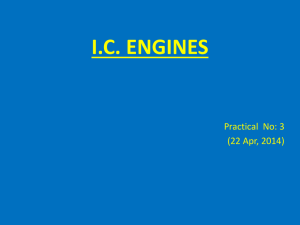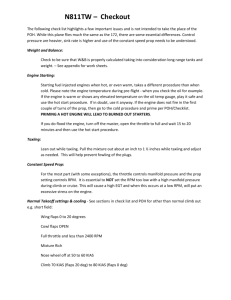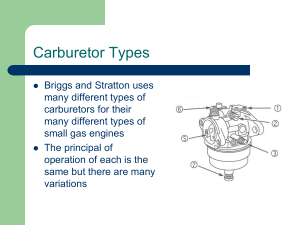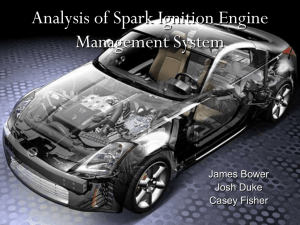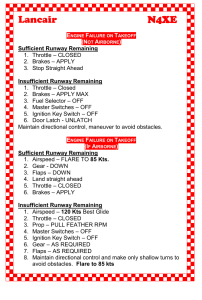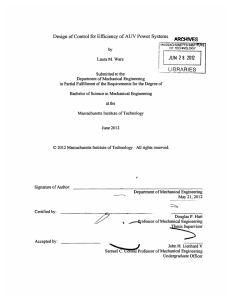Lab4 - Eden.Rutgers.edu
advertisement
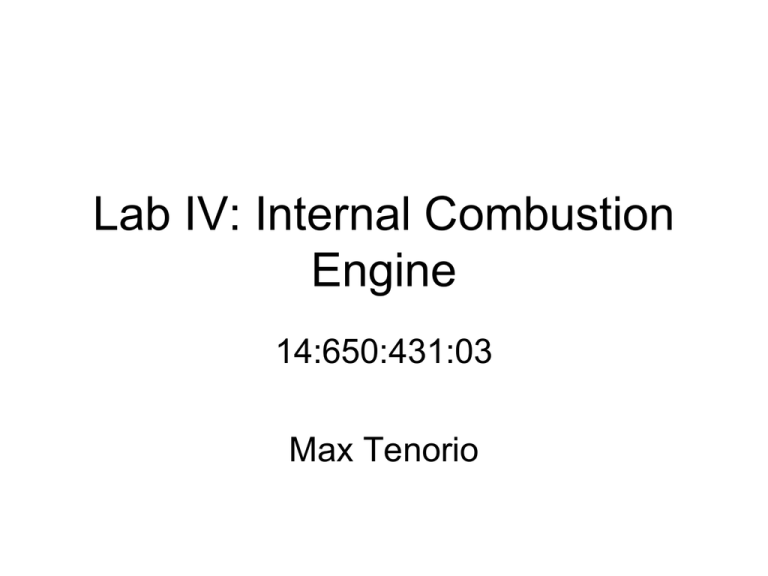
Lab IV: Internal Combustion Engine 14:650:431:03 Max Tenorio Objective The four-stroke internal combustion engine undergoes the Otto cycle, which is the most commonly used thermodynamic cycle in combustion engines. The objective of this lab is to run an engine test, and to learn how to use engine performance evaluation parameters and procedures. We can use these parameters and procedures to gain insight on the general characteristics of the cycle as well as the performance of a particular engine. This can in turn help us increase the efficiency of an engine and determine at what throttle levels and speed will be most efficient for a specific purpose. Setup 5.5 hp Honda GX 160 engine connected to a dynamometer Piston engine: geometry and components Measurements • • • • • • • • Engine RPM Dynamometer Oil Pressure Dynamometer Oil Flow Rate Dynamometer Oil Temperature Engine Cylinder Head Temperature Fuel difference Throttle level Engine Run Time Recorded Data Some Conversion Factors revolution s 1 min RPM revolution s min 60 sec 60 sec lbs 0.45359237 kg 39.37007872 in 2 9.80667m 2 PSI 6894.77Pa 2 2 s 1lbs in 1m 3 Gal 3.78541178 L 0.001m 3 1 min Gal 5 m 6.309019633 10 min 1Gal 1L 60sec min s 1 Watt = 0.00134102209 horsepower Nm 0.22480894 3lbf 1 ft Nm 0.737562149 lbf ft 1N 0.3048 m Engine Power/Brake Power Power is a measure of torque per unit time. This unit can be converted into either torque or force output by the engine and through the crankshaft. Power p Q p Q BrakePower p Power is the calculated power from the engine. Brake Power is the engine power taking the p 0.8 pump efficiency into account. From the graph, we see that the highest amount of power comes from a combination of full throttle at its highest recorded load output. It is also worth noting that at low throttle, the power peaks at a lower RPM and has a lower magnitude at higher RPMs. This shows that with a low throttle setting, increasing the load is not a good idea. Torque Engine Torque is calculated by taking the Power factor and using the revolutions per minute to remove the time factor. Pb 2N Pb BrakePower N rev / s From the graph, we can see that the highest torque is obtained from a full full throttle with a low load setting. Fuel Consumption Fuel Consumption is the rate at which fuel is drawn into the engine. Through conversions in the recorded fuel used in a span of 30 seconds obtains this data for us. The unit is output in lbs of gasoline per hour. From the graph, we see that the overall highest level of fuel consumption happened naturally at full throttle and full load. However, at 2600 RPM, three-quarter load actually had a higher rate of fuel consumption than full throttle. Because of this we cannot draw a clear conclusion as to what yields the highest level of fuel consumption as more data is needed. Brake Specific Fuel Consumption Brake Specific Fuel Consumption is essentially the measure of fuel used per unit of torque output by the engine. It can be seen as a measure of efficiency. BSFC mf Pb m f FuelMassFlowRate Pb BrakePower Assuming 1 Nm of torque at constant load, from the graph we see that low throttle and high load tends to use up the most amount of fuel, whereas full throttle and high load uses up considerably less fuel. Essentially, one quarter throttle gives you less torque per gallon of fuel than full throttle at a constant load. Cycle Efficiency Cycle efficiency is a measure of how efficient the engine is at turning fuel into useable energy. f Pb m f H HV Pb BrakePower m f FuelMassFlowRate H HV 44 106 J Kg HHV is called the Higher Heating Value of the Fuel, given by the lecture manual. From the graph, Cycle efficiency is highest with full throttle and low load. Efficiency for all throttle values tend to decline as load is increased. Brake Mean Effective Pressure Brake Mean Effective Pressure is the mean effective pressure inside the cylinder at the moment of combustion that creates power. BMEP Pb n p Vd N Pb BrakePower np revolutions/power stroke Vd displacement volume N revolutions/unit time From the graph we see that the pressure inside the cylinder is the highest at full throttle and low load. This graph has almost the same figure as the Torque graph. This is most likely because the Mean Effective Pressure and Torque are almost directly related. It also makes sense because the highest torque corresponds to the highest effective pressure. Otto Cycle As defined in the lecture manual, thermal efficiency of the Otto cycle is: where is defined as the Compression ratio and is the ratio of specific heat capacities for constant pressure and constant volume, respectively We are using regular gasoline which has an octane rating of about 87. From the Lecture Manual, this has a compression ratio of 7:1 I was not able to find a ratio of specific heat capacities for regular gasoline, however substituting a similar gas, propane (C3H8) we use γ = 1.13 This yields a maximum thermal efficiency of ηth= 22.35% A higher compression ratio would yield a high maximum thermal efficiency. This calculated thermal efficiency is quite low in comparison to methane, with a Compression Ratio of about 11:1, octane rating of 107, and γ = 1.32 which yields ηth= 53.57% More accurate numbers would yield a more accurate thermal efficiency for gasoline. 2900 RPM We are finally asked to calculate theoretical values for an engine at 2900 RPM. a) The Maximum Piston Speed We can use the equation from the Lecture Manual Where Sp = Piston Speed L = stroke; N = rotational speed; θ = crank angle; R = connecting rod length L=2 , N=2900*2pi, and R= 0.105m, leaving us with θ as our independent variable. Optimization yields θ = 323° which gives a value of 0.56m/s b) The number of times per second that the spark plug fires 2900RPM=48.33 RPS This is a 2 stroke engine, which fires twice every 4 revolutions 48.33RPS*2 fires / 4 Rev = 24.1667 strikes per second c) The approximate tensile stress induced on a connecting rod with a 1-cm2 cross-section as a result of the deceleration of a 0.3-kg piston during each cycle Downward Force = 0.3kg*9.8m/s2 = 2.94N 1 cm2 cross-section = 0.0001 m2 Tensile Stress = Downward Force / Cross Sectional Area = 2.94/0.0001=29.4kPa References • Lab Manual • Lecture Manual • Wikipedia: Heat capacity ratio
